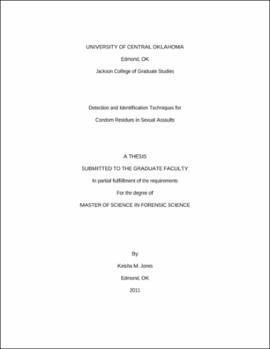| dc.contributor.advisor | Jourdan, Thomas | |
| dc.contributor.author | Jones, Keisha M. | |
| dc.date.accessioned | 2020-05-26T20:37:27Z | |
| dc.date.available | 2020-05-26T20:37:27Z | |
| dc.date.issued | 2011 | |
| dc.identifier.other | (AlmaMMSId)9978492885202196 | |
| dc.identifier.uri | https://hdl.handle.net/11244/324653 | |
| dc.description.abstract | This study investigated techniques used to detect and identify condom residues in sexual assaults. There were 10 condom brands/sub-brands analyzed, which were chosen based on the geographical locations of the manufacturers. Polarized light microscopy was implemented as an initial means of detecting condom residues by identifying common particulates added during production. It was found that starch was present in only 5 of the condom brands/sub-brands, and no other particulates were identified. These results led to the conclusion that this technique would not be effective as a general screen for the presence of condom residues. Gas chromatography/mass spectrometry (GC/MS), coupled with liquid-liquid extraction and later solid-phase microextraction (SPME) were explored with the intentions of building a database that could suggest a condom brand in the instance of an unknown source, i.e., from a criminal investigation. The foundation of this work was based on a protocol outlined in an unpublished work by Wolfgang Keil, Andrea Berzlanovich, and Robert Blackledge. Alkaline extractions were conducted on condom residues and in some instances, derivatization was performed. Analysis revealed that SPME, using a polyacrylate fiber, produced satisfactory results. This technique produced total ion chromatograms with distinct variations between condom brands and some of the sub-brands, while the mass spectra identified multiple components in the residues. Isotope-ratio mass spectrometry (IRMS) was also undertaken to determine if the carbon isotopic ratios of condom residues differed among brands. Three different ratios were observed, suggesting the possibility that manufacturers obtain their lubricants, polydimethylsiloxane, from different geographical sources. | |
| dc.rights | All rights reserved by the author, who has granted UCO Chambers Library the non-exclusive right to share this material in its online repositories. Contact UCO Chambers Library's Digital Initiatives Working Group at diwg@uco.edu for the permission policy on the use, reproduction or distribution of this material. | |
| dc.subject.lcsh | Condom use | |
| dc.subject.lcsh | Mass spectrometry | |
| dc.title | Detection and identification techniques for condom residues in sexual assaults. | |
| dc.type | Academic theses | |
| dc.contributor.committeeMember | Bost, Robert | |
| dc.contributor.committeeMember | Bowen, John | |
| dc.thesis.degree | M.S., Forensic Science | |
| dc.identifier.oclc | (OCoLC)ocn838638294 | |
| uco.group | UCO - Graduate Works and Theses::UCO - Theses | |
| thesis.degree.grantor | Jackson College of Graduate Studies | |
